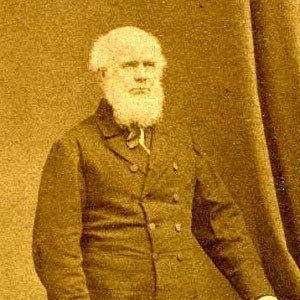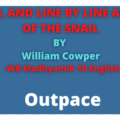About the Poet:

William Howitt was born on 18th December 1792 at Heanor in Derbyshire. He got his education in Ackworth at the Friends Public School. He got his first poem published in 1814. In 1821, he got married to Mary Botham who was a poet herself. Both of them worked together mostly and achieved a pretty successful literary career. Howitt was very much intrigued by the nature and natural occurring. In 1831, he produced a piece of work called “The Book of the Seasons, or the Calendar of Nature”. This consisted of the history of the physical changes that each month of the year brought, in the nature.
Howitt got support from the liberals after he wrote “Popular History of Priestcraft” in the year of 1833. Karl Marx quoted one of his works (“Colonization and Christianity”, published in 1838) in “Capital, Volume 1”.
Some of his famous works includes “The Rural Life England” (1838), “Land, Labour, and Gold; or, Herbert’s Note- Book” (1855), “The Man of the People” (1860), “The History of Discovery in Australia, Tasmania, and New Zealand” (1865).
He passed away on 3rd March, 1879 in Rome at the age of 86.
About the Poem
The entire poem is composed as though the breeze is repeating its considerations. The breeze is in the disposition for some fun and all set to cause an upheaval. It shook different sign sheets. The apples and oranges tumbled off the trees and moved on the ground a lot to the pleasure of young children who ran behind them to gather the same number of fruits as they could.
The breeze continued to make ruin on a ranch where it culled at the tails of cows and threw the manes of horses. From that point onward, it began indicating its capacity on the birds laying on tree limbs and terrifying other animals.
Structure
The Wind in a Frolic
“The wind one morning sprang up from sleep, Saying, ‘Now for a frolic! now for a leap! Now for a mad-cap, galloping chase! I'll make a commotion in every place!’ So it swept with a bustle right through a great town, Creaking the signs, and scattering down Shutters; and whisking, with merciless squalls, Old women's bonnets and gingerbread stalls. There never was heard a much lustier shout As the apples and oranges trundled about; And the urchins, that stand with their thievish eyes Forever on watch, ran off each with a prize. Then away to the field it went blustering and humming, And the cattle all wondered whatever was coming. It plucked by their tails the grave, matronly cows, And tossed the colts' manes all about their brows, Till, offended at such a familiar salute, They all turned their backs, and stood sullenly mute. So on it went, capering and playing its pranks: Whistling with reeds on the broad river's banks; Puffing the birds as they sat on the spray, Or the traveller grave on the king's highway. It was not too nice to hustle the bags Of the beggar, and flutter his dirty rags. 'Twas so bold, that it feared not to play its joke With the doctor's wig, or the gentleman's cloak. Through the forest it roared, and cried gaily, ‘Now, You sturdy old oaks, I'll make you bow!’ And it made them bow without more ado, Or it cracked their great branches through and through. Then it rushed like a monster on cottage and farm, Striking their dwellers with sudden alarm; And they ran out like bees in a midsummer swarm. There were dames with their 'kerchiefs tied over their caps, To see if their poultry were free from mishaps The turkeys they gobbled, the geese screamed aloud, And the hens crept to roost in a terrified crowd; There was rearing of ladders, and logs laying on, Where the thatch from the roof threatened soon to be gone. But the wind had passed on, and had met in a lane With a schoolboy, who panted and struggled in vain, For it tossed him, and twirled him, then passed, and he stood With his hat in a pool, and his shoe in the mud. Then away went the wind in its holiday glee, And now it was far on the billowy sea, And the lordly ships felt its staggering blow, And the little boats darted to and fro. But lo! it was night, and it sank to rest On the sea-bird's rock, in the gleaming west, Laughing to think, in its fearful fun, How little of mischief it really had done”
It is a simple piece where a line rhymes with the immediate next line, that is, aabbccddee…
Line by line Analysis
Stanza 1 (Lines 1-4)
“The wind one morning sprang up from sleep,
Saying, ‘Now for a frolic! now for a leap!
Now for a mad-cap, galloping chase!
I'll make a commotion in every place!’”
In the first stanza, the wind is said to have suddenly woke up one day and decided to start a commotion and some recklessness, just for a “frolic” and fun. Basically, it is the beginning of a storm.
Stanza 2 (Lines 5-12)
“So it swept with a bustle right through a great town,
Creaking the signs, and scattering down
Shutters; and whisking, with merciless squalls,
Old women's bonnets and gingerbread stalls.
There never was heard a much lustier shout
As the apples and oranges trundled about;
And the urchins, that stand with their thievish eyes
Forever on watch, ran off each with a prize.”
After deciding to create a havoc, the wind swept with huge hustle and bustle and passes through a town. The winds make the signboards creak and shatter. The shops were in mess. The fruits tumbled out of their respective baskets in the shops, and were rolling on the streets. The young kids came on the streets to gather the fruits. Each fruit has been considered to be a reward. The sounds of the gusty winds are said to be a “lustier” shout.
Stanza 3 (Lines 13-18)
“Then away to the field it went blustering and humming,
And the cattle all wondered whatever was coming.
It plucked by their tails the grave, matronly cows,
And tossed the colts' manes all about their brows,
Till, offended at such a familiar salute,
They all turned their backs, and stood sullenly mute.”
After passing through the town, it approaches the fields. The cattle were confused initially but later got terrified. The other animals and birds got scared too. After being confused, the cattle stood still for a while, not realising what is actually happening. This was not a familiar situation to them, so they did not know how to react to the rough sudden winds.
Stanza 4 (Lines 19-24)
“So on it went, capering and playing its pranks:
Whistling with reeds on the broad river's banks;
Puffing the birds as they sat on the spray,
Or the traveller grave on the king's highway.
It was not too nice to hustle the bags
Of the beggar, and flutter his dirty rags.”
After creating havoc in the market and the fields, the winds continued playing its tricks and pranks, scaring away the birds as they were sitting on their branches. The winds also passed the traveller’s grave and the highway of the king. The beggar’s dirty rags got damaged and it wasn’t a pleasant thing to happen.
Stanza 5 (Lines 25-30)
“'Twas so bold, that it feared not to play its joke
With the doctor's wig, or the gentleman's cloak.
Through the forest it roared, and cried gaily, ‘Now,
You sturdy old oaks, I'll make you bow!’
And it made them bow without more ado,
Or it cracked their great branches through and through.”
It was bold of the storm to not fear to play such pranks. The doctor’s wig flew off and a man’s cloak flew away as well. It was as if the oaks were bowing in front of the gusty and strong winds. Without much delay, the winds decided the break off the branches as well.
Stanza 6 (Lines 31-33)
“Then it rushed like a monster on cottage and farm,
Striking their dwellers with sudden alarm;
And they ran out like bees in a midsummer swarm.”
The winds then reached the huts and cottage. The people who lived there got so scared that they ran out of their respective houses for saving own lives like a swarm of bees.
Stanza 7 (Lines 34-39)
“There were dames with their 'kerchiefs tied over their caps,
To see if their poultry were free from mishaps
The turkeys they gobbled, the geese screamed aloud,
And the hens crept to roost in a terrified crowd;
There was rearing of ladders, and logs laying on,
Where the thatch from the roof threatened soon to be gone.”
Women tied handkerchiefs on their caps and tried to make sure if their poultry was fine. The turkeys, geese and hens screamed in terror. The roofs of the huts were threatened to be blown away too. The ladders and logs made noises.
Stanza 8 (Lines 40-51)
“But the wind had passed on, and had met in a lane
With a schoolboy, who panted and struggled in vain,
For it tossed him, and twirled him, then passed, and he stood
With his hat in a pool, and his shoe in the mud.
Then away went the wind in its holiday glee,
And now it was far on the billowy sea,
And the lordly ships felt its staggering blow,
And the little boats darted to and fro.
But lo! it was night, and it sank to rest
On the sea-bird's rock, in the gleaming west,
Laughing to think, in its fearful fun,
How little of mischief it really had done”
Now the winds met a schoolboy. They tossed and turned him. The kid struggled and wanted to escape but to no avail. His hat fell in the pool and shoes landed in a puddle of mud. The winds threw the boy away and moved to the sea. The winds then hit the boats there making them struggle a lot. Some small boats sank. After doing all the mishap, the winds passed away thinking about the “little mischief” that he created.
Figures of speech used in the Poem
- Personification is a literary device in which animals, or other inanimate objects are credited with human feelings, emotions and abilities.
The whole poem is an example of personification. Here the wind is personified with human abilities.
- Oxymoron: It is a figure of speech where two contradicting words are placed next to each other in a sentence.
- “Laughing to think, in its fearful fun,”
- Simile: In this figure of speech, a comparison is made with the usage of any comparing words (“like”, “as”)
- “Then it rushed like a monster on cottage and farm,”.
Glossary:
- Playful/ Cheerful.
- Eccentric/ Reckless/ Wild.
- Turmoil/ Chaos.
- A sudden storm that is usually violent in nature.
- Moving in a playful way.
- Immediately.
- Matured nature and behaviour of a woman.
- Blowing fiercely.
- Rough/ Filled with air.
The theme of the Poem
The central theme revolves around the gusty winds or what we call a storm. The whole poem is about how nature can be devastating without a prior warning even. The wind in the poem is said to “wake up” one day and realised that it needs to “do something fun”. This whole process created much havoc and turmoil in the whole town. The little mischief of the wind led to devastating results, which probably the wind never realised. This is similar to human behaviour too, when they do not realise what a little act of mischief can lead to.
Textbook Solutions
1. What did the wind plan to do one day? Was it successful?
Ans: The wind woke up from sleep one day, and decided to do something fun. It wanted to just move recklessly and create a turmoil all over the place just for some little mischief.
It was successful in creating the havoc across the town that it swept by. The people, animals, trees and everything else got terrified due to the “fun” that the wind was having.
2. What was the effect of the wind on the town?
Ans: The wind had a devastating effect on the whole town. The markets got hit and the fruits rolled on the streets. The bonnets and gingerbread stalls shattered. The cattle stood there confused at first. The people living in the huts ran out to save their lives. The roofs were almost about to blow off. The shops, houses, trees and even boats were rattled due to the gusty, strong winds.
3.What route did the wind take after it woke up from its sleep?
Ans: The wind began its journey with the market of the town, it passed the stalls and reached the fields and then the broad river banks. Later it crossed the traveller’s grave and the king’s highway. The next stoppage was the cottage and a farm after then. After creating turmoil all over the town, the winds approached the seas and left
4. How long did the wind’s pranks continue?
Ans: The wind continued with its pranks for quite some time. The havoc started in the morning and lasted till night, as mentioned in the poem. Thus, the wind’s pranks continued for a whole day.
5. What was the effect of the wind on humans, animals and other aspects of nature?
Ans: The humans and animals were totally terrified due to the storm. The people started running out of their cottages to save their lives, so that the cottages don’t collapse on them. The cattle stood their confused, not realising what was happening. The birds got rattled too. The turkeys, geese and hens panicked. Overall, every creature got affected by the winds.
6.Is the pace of the poem slow or fast? Underline the words and expressions that show the pace with which the wind moves.
Ans: The pace of the poem is slow, because it took a long time for the poet to reach to the end of the storm, even when it was a single event. The whole poem is about one natural happening, that is the storm. The poem has very beautifully expressed the effects of the gusty winds.
The words showing the pace with which the wind moves are: bustle, blustering, capering, rushing, passed on.
- 7. ‘There never was heard a much lustier shout
As the apples and oranges trundled about;
And the urchins, that stand with their thievish eyes
Forever on watch, ran off each with a prize.’ - Why does the poet call it ‘a lustier shout’?
- What prize did the urchins run off with?
- Why did the apples and oranges tumble about?
Ans: a. The winds passed the stalls and the shops, the women screamed vigorously out of fear. That is the “lustier shout” that has been referred to, in the poem.
b. The urchins ran off to the streets to collect the apples and oranges. The prize means the fruits that have tumbled from the shops.
c. The fruits have tumbled about because of the gusty winds that have passed through the stalls in the market of the town.
8. What is the mood conveyed in the poem? Tik the correct option. Give reasons for your answer.
- Sadness
- Excitement
- Frustration
- Annoyance
Ans: Sadness is conveyed in the poem. The devastating effects of a storm had been beautifully penned down. Although, it is considered to be a “fun” activity for the wind, it creates a havoc amongst human life as well as on other creatures.
9.Is the title of the poem appropriate? Support your answer with reasons.
Ans: The title of the poem sounds ironical in nature. “The Wind in a Frolic” sounds like a cheerful title. Frolic refers to an enjoyable activity. The poem consists of various events like people running away, animals screaming in fear, etc., none of which should be a result of an enjoyable activity.
11. Which lines in the poem help you to imagine the funniest pictures or scenes?
Ans: The lines in the poem that helped us imagine the funniest scenes are as follows:
- “’Twas so bold, that it feared not to play its joke
With the doctor’s wig, or the gentleman’s cloak.” - “For it tossed him, and twirled him, then passed, and he stood
With his hat in a pool, and his shoe in the mud.” - “And the urchins, that stand with their thievish eyes
Forever on watch, ran off each with a prize.”




